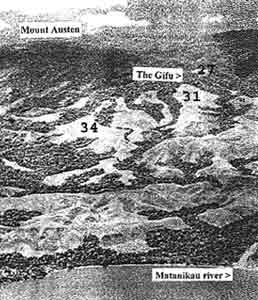|
|
|
|
| Missing In Action (MIA) | Prisoners Of War (POW) | Unexploded Ordnance (UXO) |
| Chronology | Locations | Aircraft | Ships | Submit Info | How You Can Help | Donate |
|
 US Army 1943 |
Location The Wright Road was built by the U.S. Army to from the north coast of Guadalcanal inland towards The Gifu near Mount Austen (Mt. Austen, Grassy Knoll). Prewar and during the Pacific War part of the British Solomon Islands Protectorate (BSIP). Today located in Guadalcanal Province in the Solomon Islands. Still in use today as a road. Wartime History The Wright Road was built to support the U.S. Army advance inland towards Mount Austen and The Gifu. Named in honor of LTC William Curtiss Wright, Commanding Officer (C.O.) of 3rd Battalion, 132nd Infantry Regiment. By December 20, 1942 U.S. Army engineers completed a rough jeep road to Hill 35. Bill Wright adds: "I am the son of LTC William Curtiss Wright, and the nephew of CPT (Later COL Howard Wright and MSGT (later Major) Donald R. Wright all of the 132nd Infantry Regiment. The 164th Infantry, Americal Division anchored the eastern end of the Marine defensive line during the major battles to retake Henderson Field. Later, the 164th and the 184th ran combat patrols in force to the east and ran into strong opposition. The HQ, Americal Division and the 132nd Infantry Regiment with division engineer and artillery landed on about 7 December 1942 and the same convoy took the 1st MAR DIV off the island. The 132nd Infantry Regiment was the first to take the offensive in the time frame 17-19 December against Mt. Austen. The Gifu area of Mt. Austen was one of the most heavily defended sites of the War in the Pacific. There were many well fortified machine gun nests and snipers in a U-shaped defensive perimeter as you first go up Wright Road from Henderson Field. General Patch and the Americal Staff had no idea how well Mt Austen was defended. The marines thought there were just a few soldiers up there. General Patch initially sent a company. They could make no progress, were pinned down by fire, and could find no machine guns or snipers. On 17 December, the 3rd Bn, 132nd Inf Reg was sent up with the same results. The Bn Commander, LTC William C. Wright, pulled the Bn back and on 19 December, accompanied only by his bodyguards, his radioman (Johnny DiCicco), and two FO's (Forward Observers, Arty) they made contact, identifying one machine gun nest. The body guards and the radioman were wounded. In trying to lift the fire by wiping out the machine gun nest and save his men, LTC Wright was mortally wounded and later was brought back by members of his Bn. The entire regiment was later thrown at the defensive site with the 1st and 3rd Bns taking a frontal assault and the 2nd Bn scaling up the extremely steep back slopes using ropes established by expert climbers. This maneuver finished that portion of the defense. The regiment took heavy loses and the only records after that indicate that the 2nd Bn was part of the force which landed on the west side of the island and helped push the Japanese off the island at Cape Esperance." Today The present day road goes past Hill 31 and turns off to the right down a 600 yard dirt road to Barana village. Wright Road Memorial Plaque A small while pillar and plaque was placed on the right side of the road. References Thanks to Bill Wright (son of LTC William C. Wright) and John Innes for additional information Contribute
Information Last Updated
|
| Discussion Forum | Daily Updates | Reviews | Museums | Interviews & Oral Histories |
|